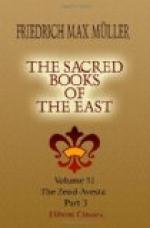Inquiries into the religion of ancient Persia began long ago, and it was the old enemy of Persia, the Greek, who first studied it. Aristotle, Hermippus, and many others wrote of it in books of which, unfortunately, nothing more than a few fragments or merely the titles have come down to us. We find much valuable information about it, scattered in the accounts of historians and travellers, extending over ten centuries, from Herodotos down to Agathias and Procopius (from B.C. 450 to A.D. 550). The clearest and most faithful account of the Dualist doctrine is found in the treatise De Iside et Osiride, ascribed to Plutarch. But Zoroastrianism was never more eagerly studied than in the first centuries of the Christian era, though without anything of the disinterested and almost scientific curiosity of the earlier times. Religious and philosophic sects, in search of new dogmas, eagerly received whatever came to them bearing the name of Zoroaster. As Xanthos the Lydian, who is said to have lived before Herodotos, had mentioned Zoroastrianism, there came to light, in those later times, scores of oracles, styled “Oracula Chaldaica sive Magica,” the work of Neo-Platonists who were but very remote disciples of the Median sage. As his name had become the very emblem of wisdom, they would cover with it the latest inventions of their ever-deepening theosophy. Zoroaster and Plato were treated as if they had been philosophers of the same school, and Hierocles expounded their doctrines in the same book. Proclus collected seventy Tetrads of Zoroaster and wrote commentaries on them; but we need hardly say that Zoroaster commented on by Proclus was nothing more or less than Proclus commented on by himself. Prodicus, the Gnostic, possessed secret books of Zoroaster; and, upon the whole, it may be said that in the first centuries of Christianity, the religion of Persia was more studied and less understood than it had ever been before. The real object aimed at, in studying the old religion, was to form a new one.
Throughout the Middle Ages nothing was known of Mazdeism but the name of its founder, who from a Magus was converted into a magician and master of the hidden sciences. It was not until the Renaissance that real inquiry was resumed. The first step was to collect all the information that could be gathered from Greek and Roman writers. That task was undertaken and successfully completed by Barnabe Brisson. A nearer approach to the original source was made in the following century by Italian, English, and French travellers in Asia. Pietro della Valle, Henry Lord, Mandelslo, Ovington, Chardin, Gabriel du Chinon, and Tavernier, found Zoroaster’s last followers in Persia and India, and made known their existence, their manners, and the main features of their belief to Europe. Gabriel du Chinon saw their books and recognized that they were not all written in the same language, their original holy writ being no longer understood except by means of translations and commentaries in another tongue.




